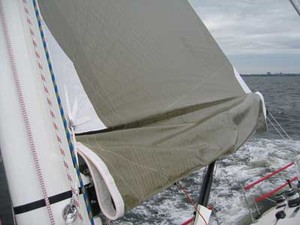Reefing - Efficiently, quickly, and EARLY
by Adam Loory, UK-Halsey Sailmakers/Nancy Knudsen on 9 May 2010

Figure 1 SW
If your boat is overpowered, it is slower because it is heeling too much. Excess heeling increases leeway and reduces the efficiency of your boat’s keel and rudder.
The boat goes slower because the rudder is fighting increased weather helm. To get the boat back under control, sail area has to be reduced.
There are two options for reducing sail area: change to a smaller genoa or reduce the size of the main by reefing.
Changing to a smaller genoa can be quicker if you have furlers, but if the wind continues to rise you may still have to address the main, and it's always better to reef earlier rather than later.
Reefing the main can be very quick. A well-set-up boat can have two people tuck in a reef in a minute or two, or one person if the boat is set up for it.
To get the most benefit from a mainsail area reduction (reefing), make sure that the reef outhaul and halyard are tensioned tight – bar tight. If those controls are loose, the sail will become too full, and full sails make you heel more when the wind is howling.
Notice how flat the foot of sail is in Figure 1. Properly built sails are reinforced to take these strains. In 2006 sailing on Richard du Moulin’s Express 37 Lora Ann, we had the second reef in the main for 24 hours as we sailed through the remains of Hurricane Ernesto.
When we shook the reef, there was no deformation of the sail. That reef outhaul was cranked on TIGHT as we blasted through winds that grew from 30 knots at the start to 48 knots by the time we rounded the Buzzard’s Bay Tower. So go ahead and winch the reef outhaul
hard.
To put in a reef, drop the main halyard far enough to set the reef tack. This is when things can get dicey if your sail has a bolt rope instead of slides because the mainsail luff has to come out of the mast as you lower it. In a lot of wind, controlling the loose sail can be difficult. Most boats have reef hooks on each side of the boom that catch the reef tack.
You have to lower the mainsail enough to get the reef tack’s ring onto the hook. Once the reef tack is made, the halyard is re hoisted -- very tight. Next, pull and winch the reef outhaul tight. Remember to ease the mainsheet and vang or else you will not be able to get the reef outhaul tight. You will know the reef outhaul is tight enough when the reef clew is down to the boom and the mainsail is pulled straight between the reef tack and reef clew.
Standing on the cabin top with the mainsail flogging makes it hard to get the reef tack onton the hook, and if the halyard does not get tensioned quickly, the tack can flog off the hook. A more secure method is shown in Figure 2. It involves a piece of low-stretch line that is attached to a pad eye on the mast with a snap shackle on the end. To set the reef tack, pass the shackle through the reef tackgrommet and then down to the pad eye on the opposite side of the mast. This method ensures that the reef tack is securely held in place. In the photo, the top of the strop for the second reef can just be seen on the pad eye.
Once the reef tack and clew have been set, there is loose sail that needs to be controlled. Just roll up the sail parallel to the boom and tie it in place with bungee cord. If you use a piece of line or a sail tie, you risk ripping the sail by shaking the reef with the ties still in place. This happens a lot at night. Sail ties can work well, because they are very visible and hard to miss when it is time to shake out the reef; see Figure 3.
Some sails do not have the grommets (reef diamonds) between the reef tack and clew at the first reef because there is not enough sail loose to worry about. The sail in Photo 1 does not have reef diamonds.
If you are going to be reefed for a long period, good seamanship calls for rigging a safety line that goes through the reef clew and around the boom. This way, if your reef outhaul breaks or the clutch holding the reef outhaul opens, the sail won’t get ripped.
With practice, you will be able to set and shake a reef quickly, skills that are needed as the wind rises and falls, but never forget the old sailor's adage, 'If you're not sure whether you should reef or not, REEF!' Reefing is one very important sail trim method that every sailor needs to know, whether you're out for a day-sail, or crossing an ocean.
For more information about UK-Halsey Sailmakers, click www.ukhalsey.com!here.
If you want to link to this article then please use this URL: www.sail-world.com/69323